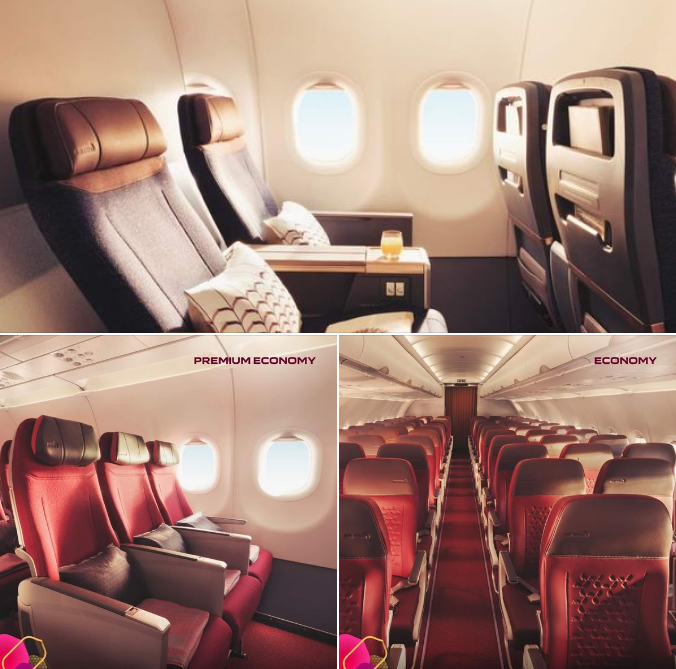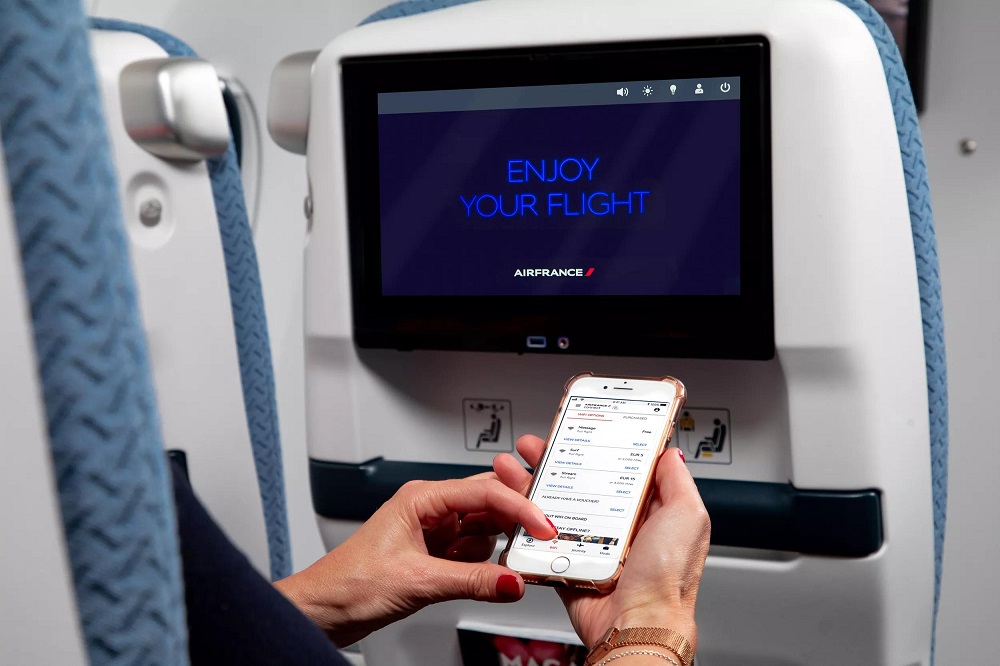Airlines
Air India Teases New Narrow Body Cabins For the A320 Fleet

Air India, India’s leading global airline, has today announced a major upgrade to its narrowbody fleet with the introduction of a three-class configuration on its newly inducted A320neo aircraft.
The airline’s new configuration will include a refreshed Business class, an all-new Premium Economy class, and a redesigned Economy class, providing an enhanced cabin experience on both domestic and short-haul international routes.
The two newly refitted A320neo aircraft, identified as VT-RTW and VT-RTZ, now feature 8 luxurious seats in Business class, 24 extra legroom seats in Premium Economy, and 132 comfortable seats in Economy.
Passengers across all three classes will benefit from several modern features aimed at improving their in-flight experience.
These include subtle cabin mood lighting, increased legroom and wider pitch, as well as amenities like portable electronic device (PED) holders and USB ports for charging mobile phones, laptops, and other gadgets.
Rollout planned across entire narrowbody fleet within next year.
Air India plans to roll out this new three-class configuration across its entire full-service narrowbody fleet within the next year. While existing aircraft are being progressively refitted, new aircraft joining the fleet will be delivered already equipped with the new configurations.
The seats in all three cabins have been customized by the leading seat manufacturer Collins Aerospace. They feature unique ergonomic contouring and a patented comfort system designed to enhance passenger comfort. Additionally, all seats are equipped with literature pockets, charging ports, tray tables, and coat hooks.
The new Business class cabins are particularly noteworthy, featuring 40-inch ergonomic seats with a deep 7-inch recline, adjustable armrests, footrests, and backrests.
All seats have ergonomic contouring & comfort
Each seat includes a tray table with a PED holder, which is extendable and can be deployed at the push of a button, and multiple charging ports. The industry-best seat upholstery in Business class ensures maximum comfort and convenience for passengers.
Premium Economy seats are larger, with superior upholstery, a four-way headrest, a wider 32-inch seat pitch, and a 4-inch recline. These seats also include amenities such as a PED holder and USB charging port.
Passengers in Premium Economy will enjoy more meal options, served in upgraded crockery and cutlery, promising a superior travel experience. Economy class seats have also been ergonomically designed, offering comfortable upholstery, a seat pitch of 28-29 inches, a 4-inch recline, and ample legroom.

Airlines
These 6 Airlines Are Giving You Free Wi-Fi on Your 2025 Flights

In a world where staying connected is more important than ever, airlines are stepping up their game by offering passengers free Wi-Fi during their flights.
Gone are the days of paying exorbitant fees to check your emails or scroll through social media at 30,000 feet. Staying connected during a flight is becoming easier than ever, and in 2025, wireless password wifi airport and several airlines are taking it a step further by offering free Wi-Fi for their passengers.
Why Elon Musk Believes the F-35 Stealth Jet Is Obsolete – Here’s Why
Here’s a look at six airlines that are leading the way in offering free high-speed internet for everyone on board.
- 1.Air France
Starting in the summer of 2025, Air France is teaming up with Starlink to offer ultra-fast Wi-Fi on all its flights. The service promises a “ground-like” internet experience and will be available free of charge for passengers in all cabin classes. To access the Wi-Fi, passengers can log in using their Flying Blue loyalty program accounts. - 2.Hawaiian Airlines
Hawaiian Airlines made history as the first U.S. airline to partner with Starlink back in 2022. By September 2024, the airline successfully installed the high-speed Wi-Fi on all of its Airbus aircraft. With this partnership, airport wifi passwords passengers can enjoy reliable internet throughout their flight. - 3.JetBlue
JetBlue has been a pioneer in offering free Wi-Fi to its passengers. The Boston-based airline was the first major carrier to provide free Wi-Fi for all its customers, regardless of cabin class. The service is powered by ViaSat, ensuring that JetBlue passengers stay connected even in the sky. - Virgin Australia Launches Black Friday Sale on Flights Worldwide
- 4.Delta Air Lines
Delta is rolling out fast, free Wi-Fi across its fleet, thanks to a partnership with T-Mobile. As of 2025, SkyMiles® Members on most domestic flights can enjoy free Wi-Fi. The airline is also working to extend this service to its international and regional routes, ensuring more passengers can stay connected. - 5.Air New Zealand
Air New Zealand is one of the first international airlines to offer free Wi-Fi, thanks to its partnership with Starlink. The airline has already rolled out free Wi-Fi on many of its flights, allowing passengers to enjoy seamless internet access while traveling to and from New Zealand. - 6.China Eastern Airlines
- China Eastern Airlines offers free Wi-Fi on select flights to and from major U.S. cities, including San Francisco and Chicago. American passengers flying on these routes can stay connected with no extra cost during their journey.
-

 Aviation2 months ago
Aviation2 months agoMicrosoft Flight Simulator Raises $3 Million to Bring Back the An-225 Mriya
-

 Airlines2 months ago
Airlines2 months agoQatar Citizens Can Travel to the United States Without a Visa
-

 Defence2 months ago
Defence2 months agoWhich Country Has the Largest Fleet of Fighter Aircraft?
-

 Airlines1 week ago
Airlines1 week agoDAMAC Air: Dubai’s New Luxury Airline Offers Free Flights for Registration
-

 Airlines1 week ago
Airlines1 week agoAir India to Launch aircraft maintenance training institute in Bengaluru
-

 Airport2 months ago
Airport2 months agoWestern Sydney Airport Welcomes Its First Plane After 6 Years of construction
-

 Aviation2 months ago
Aviation2 months agoDid you know ? Once Boeing 747 carried 1088 passenger in 1991
-

 Travel1 week ago
Travel1 week agoThis country tops visa rejections in the popular Schengen countries








